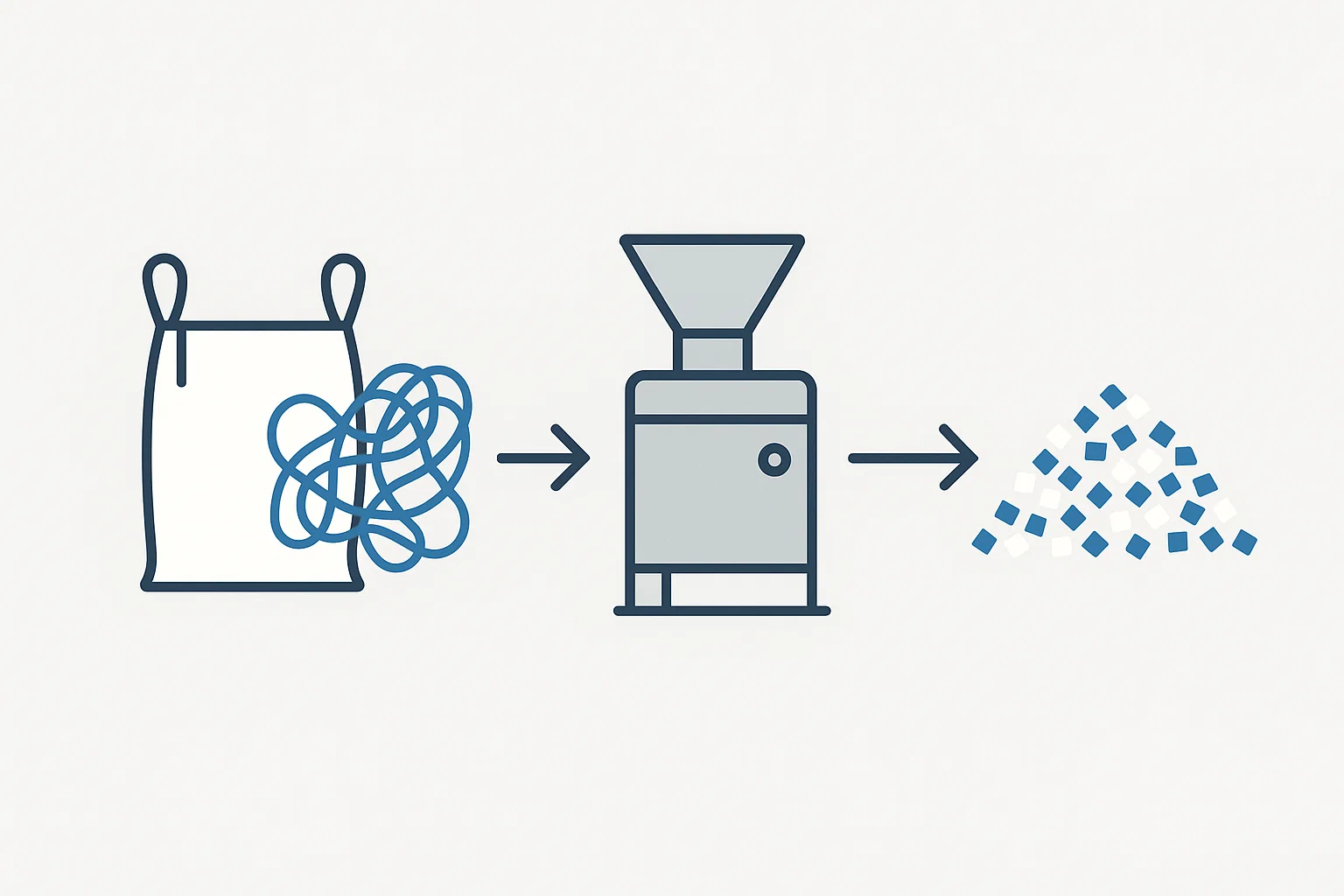산업 재활용 분야에서 유연 중간 벌크 용기(FIBC), 톤백, 그리고 수명이 다한 어망만큼 까다로운 소재는 드뭅니다. 두 소재 모두 폴리프로필렌(PP)이나 나일론과 같은 귀중한 폴리머를 상당량 포함하고 있지만, 견고하고 유연하며 섬유질인 특성 때문에 일반적인 재활용 장비는 완전히 중단될 수 있습니다.
이처럼 까다로운 폐기물을 수익성 있는 자원으로 성공적으로 전환하는 것은 단순한 힘만으로는 불가능합니다. 정밀한 엔지니어링과 관련된 기술적 세부 사항에 대한 깊은 이해가 필수적입니다. 이 분야에 투자하려는 제조업체와 재활용 전문가에게 있어 효율성, 수익성, 그리고 운영 안정성을 확보하기 위해서는 적절한 장비를 선택하는 것이 무엇보다 중요합니다.
Energycle Machine은 이러한 까다로운 용도에 맞는 솔루션을 설계하고 구현하는 데 있어 풍부한 경험을 보유하고 있습니다. 이 가이드는 Energycle Machine의 전문 지식을 집약하여 FIBC 백과 어망을 효과적으로 파쇄하기 위해 고려해야 할 중요한 기술적 세부 사항을 살펴봅니다.
재료 이해: 두 가지 견고한 플라스틱 이야기
기계에 들어가기 전에, 이러한 소재들이 가공하기 어려운 이유를 이해하는 것이 중요합니다. 두 소재 모두 유연하지만, 각기 다른 특성을 가지고 있어 맞춤형 접근 방식이 필요합니다.
FIBC(톤백/점보백):
- 재료: 주로 내구성과 탄력성이 뛰어난 폴리머인 폴리프로필렌(PP)으로 짠 것입니다.
- 건설: 짠 직물 구조는 놀라운 인장 강도를 제공하며, 찢어지지 않고 1톤 이상의 재료를 견딜 수 있도록 설계되었습니다.
- 과제:
- 고강도: 절단에도 강하고, 늘어나거나 기계 부품 주위로 감쌀 수 있습니다.
- 연마 오염: 종종 분쇄기 칼날의 빠른 마모를 유발하는 잔여 모래, 자갈, 시멘트 또는 기타 연마재가 포함되어 있습니다.
- 체적 밀도: 밀도 있고 압축된 베일로 공급해야 하므로 강력하고 지능적으로 제어되는 공급 시스템이 필요합니다.
어망:
- 재료: 일반적으로 나일론(PA6, PA6.6), 고밀도 폴리에틸렌(HDPE), 폴리프로필렌(PP)과 같은 고강도 폴리머로 만들어집니다.
- 건설: 길고, 서로 얽혀 있고, 종종 매듭이 있는 필라멘트로 구성됨.
- 과제:
- 극단적인 얽힘: 이것이 가장 큰 과제입니다. 길고 강한 섬유는 회전하는 부품을 휘감는 경향이 매우 강해서, 파쇄기의 회전자를 몇 초 만에 덮칠 수 있는 "새 둥지"와 같은 구조를 형성합니다.
- 높은 인장 강도: 특히 나일론은 매우 질기고 탄력이 좋아서 깨끗하게 자르기가 어렵습니다.
- 해양 오염: 종종 바닷물 생물, 소금, 모래, 때로는 금속 성분(추, 갈고리)으로 더러워져 연마성과 부식성이 있습니다.
| 특징 | FIBC(톤) 백 | 어망 |
|---|---|---|
| 1차 폴리머 | 폴리프로필렌(PP) | 나일론(PA), PE, PP |
| 핵심 과제 | 높은 강도 및 연마성 | 극한의 얽힘과 탄력성 |
| 일반 형식 | 묶음으로 압축된 시트 | 느슨하고 엉킨 묶음 |
| 오염 물질 | 모래, 자갈, 제품 잔여물 | 소금, 모래, 유기물, 금속 |
표준 분쇄기가 실패하는 이유: 일반적인 함정
일반적인 분쇄기나 부적절하게 구성된 분쇄기를 사용하여 이러한 재료를 처리하려고 하면 종종 일련의 비용이 많이 드는 운영상의 실패로 이어집니다.
- 재료 포장(얽힘): 가장 흔한 고장 지점입니다. 유연한 소재가 로터 샤프트, 블레이드와 본체 사이를 단단히 감싸고 있습니다. 이로 인해 광범위하고 위험하며 시간이 많이 소요되는 수동 세척이 필요하며, 이로 인해 상당한 가동 중단 시간이 발생합니다.
- 낮은 처리량: 이러한 소재용으로 설계되지 않은 기계는 소재를 잡아 절단실로 효과적으로 끌어들이는 데 어려움을 겪습니다. 소재가 로터 위에 "떠다니거나" 공급 호퍼를 막을 수 있습니다.
- 과도한 블레이드 마모: 모래와 같은 연마성 오염 물질은 절삭날을 빠르게 무디게 만듭니다. 무딘 칼날은 자르는 대신 찢어지게 하여 엉킴을 심화시키고 에너지 소비를 증가시킵니다.
- 일관되지 않은 입자 크기: 절단 작업이 제대로 이루어지지 않으면 대형 조각과 미세 먼지가 섞여 발생하는데, 이는 세척 및 압출과 같은 후속 공정에 문제를 일으킵니다.
이러한 문제를 해결하려면 특수 기계가 필요합니다. 이러한 응용 분야에는 견고한 단일 샤프트 분쇄기 종종 가장 효과적인 시작점이지만, 이는 특정 기술적 수정을 통합할 때에만 가능합니다.
솔루션: 최적화된 분쇄기의 주요 기술 사양
성공은 디테일에 있습니다. FIBC 및 어망용 고성능 파쇄기는 모든 구성 요소가 조화롭게 작동하여 엉킴을 방지하고 깨끗하고 효율적인 절단을 보장하도록 설계된 시스템입니다.
1. 로터 설계: 엉킴 방지 코어
로터는 파쇄기의 핵심입니다. 섬유 소재 처리에 있어 로터의 설계는 가장 중요한 요소입니다.
- 분할형, 'V-컷' 또는 'C-컷' 로터: 일반 플랫 로터와 달리, 특수 로터는 'V'자 또는 오목한('C') 프로파일을 특징으로 합니다. 이 디자인은 재료를 커터 중앙으로 적극적으로 유도하여 찢는 동작보다는 슬라이싱 동작을 촉진합니다. 로터 본체의 분할 구조는 재료가 휘감길 수 있는 평평한 표면을 최소화합니다.
- 낮은 회전 속도(RPM) 및 높은 토크: 어떤 사람들에게는 직관에 어긋나 보일 수 있지만, 매우 중요합니다. 느린 로터 속도(일반적으로 60~90RPM)와 높은 토크의 기어박스가 결합되면, 질기고 탄성이 있는 소재를 감아올리는 데 필요한 엄청난 회전력을 얻을 수 있습니다. 중요한 것은 속도가 아니라 제어된 힘입니다.
2. 절단 기술: 블레이드 및 카운터 블레이드
커터는 물리적인 작업을 수행하며, 커터의 형태와 재료가 매우 중요합니다.
- 오목하고 갈고리 모양의 칼날: 각 커터 날은 오목하거나 갈고리 모양이어야 합니다. 이러한 형상 덕분에 유연한 소재를 적극적으로 잡고, 뚫고, 카운터 블레이드에 대고 당겨 가위처럼 정확하게 절단할 수 있습니다. 일반적인 사각 날은 소재를 밀고 늘리는 경향이 있습니다.
- 경질 및 특수 강철: 모래와 자갈에 의한 마모를 방지하려면 블레이드는 고품질 내마모성 공구강(예: D2, Chipper)으로 제작되어야 하며, 표면 경화 처리가 되어 있어야 합니다. 절삭날에 매우 단단한 소재를 용접하면 블레이드 수명이 3~5배 증가하여 운영 비용을 크게 절감할 수 있습니다.
- 최적화된 블레이드 클리어런스: 회전 블레이드와 고정된 카운터 블레이드 사이의 간격은 정확하게 설정되어야 합니다. 너무 넓으면 재료가 절단되지 않고 비집고 들어가 긴 스트립과 엉킴을 초래할 수 있습니다. 너무 좁으면 마찰과 마모가 증가합니다. Energycle Machine 전문가는 특정 재료에 따라 이 간격을 조정할 수 있습니다.
3. 지능형 공급 시스템: 유압식 푸셔 램
재료가 로터에 어떻게 전달되는지는 절단 작업 자체만큼 중요합니다.
- 부하 감지 제어: 정교한 유압식 푸셔 램은 필수적입니다. 램은 메인 로터 모터의 전류 소모량을 모니터링하는 부하 감지 시스템에 의해 제어되어야 합니다. 모터 부하가 급증하면(재료의 단단한 부분을 나타냄) 램이 자동으로 약간 수축하여 압력을 완화하고 로터가 재료를 제거한 후 계속 밀어낼 수 있도록 합니다. 이를 통해 과부하, 정지, 걸림을 방지할 수 있습니다.
- 프로그래밍된 램 사이클: 매우 어려운 소재의 경우, 램을 특정 "니블링" 사이클로 프로그래밍하여 짧고 제어된 스트로크로 앞으로 밀어서 소재를 커터에 점진적으로 공급할 수 있습니다.
4. 화면 선택: 출력 정의
로터 아래의 천공 스크린은 파쇄된 재료의 최종 크기를 결정합니다.
- 구멍 크기 대 처리량: 더 큰 스크린 구멍 직경(예: 80~100mm)은 처리량은 증가하지만 입자 크기가 커집니다. 더 작은 구멍(예: 40~50mm)은 더 미세하고 균일한 파쇄를 생성하여 세탁 라인에 적합하지만 전체 처리량은 감소합니다.
- 눈부심 방지 디자인: 매우 미세하거나 약간 끈적거리는 소재의 경우, 스크린이 막히거나 막힐 수 있습니다. 특수 스크린 설계와 날카로운 절단 동작을 통해 이러한 현상을 최소화할 수 있습니다.
체계적 접근: Energycle 기계의 장점
Energycle Machine은 파쇄기가 단독으로 작동하는 경우가 드물다는 것을 잘 알고 있습니다. 파쇄기는 완전한 재활용 라인의 초석입니다. 저희는 최대 효율을 위한 완벽한 통합에 중점을 두고 있습니다.
1. 입력: 묶인 FIBC나 느슨하고 엉킨 어망을 컨베이어에 싣습니다.
2. 전처리(선택 사항이지만 권장):
* 베일 브레이커: 고압축 FIBC 베일용.
* 초기 크기 감소: 사전 분쇄기나 단두대를 사용하면 큰 묶음의 그물을 더 다루기 쉬운 부분으로 잘라낼 수 있습니다.
* 오염물질 제거: 모래 제거 시스템이나 수동 분류를 통해 큰 금속 조각을 제거합니다.
3. 핵심 공정: Energycle Machine 단일 샤프트 분쇄기:
* 재료는 위에서 설명한 로터, 블레이드, 제어 시스템으로 특별히 구성된 파쇄기로 공급됩니다. 이를 통해 균일하고 제어된 입자 크기(예: <60mm)가 생성됩니다.
4. 다운스트림 처리:
* 전달: 파쇄된 재료는 다음 단계로 운반됩니다.
* 세척 및 분리: 마찰 세척기와 플로트 싱크 탱크는 먼지, 소금 및 기타 오염 물질을 제거합니다.
* 건조: 기계적 건조기나 열 건조기는 수분을 제거합니다.
* 펠릿화/압출: 깨끗하고 건조한 플레이크를 합성하고 압출하여 고품질 재활용 펠릿을 만들고, 이를 통해 새로운 제품을 제조할 수 있습니다.
재료에 맞춰 파쇄기를 최적화함으로써 다운스트림 장비가 일관되고 고품질의 원료를 공급받도록 보장하여 전체 공장의 효율성을 개선합니다.
자주 묻는 질문(FAQ)
1. 같은 기계로 FIBC 백과 어망을 모두 파쇄할 수 있나요?
네, 가능합니다. 하지만 각 재료에 대한 최적의 구성은 약간씩 다를 수 있습니다. Energycle Machine 분쇄기는 다양한 설정과 쉽게 교체 가능한 스크린을 통해 두 가지 재료를 모두 효과적으로 처리할 수 있도록 설계될 수 있습니다. 중요한 것은 사양 결정 과정에서 엔지니어와 귀사의 전체 공급 원료 범위에 대해 논의하는 것입니다.
2. 파쇄하기 전에 모래나 금속과 같은 오염 물질을 제거하는 것이 얼마나 중요합니까?
매우 중요합니다. 저희 파쇄기는 견고하고 내마모성이 뛰어난 부품으로 제작되었지만, 대형 금속 물체를 제거하기 위한 사전 분류 작업을 통해 심각한 손상을 방지할 수 있습니다. 과도한 모래와 자갈을 제거하면 칼날 수명이 크게 연장되어 톤당 비용이 절감되고 고품질 절단 품질을 유지할 수 있습니다.
3. 내 시설에 필요한 적절한 크기의 분쇄기와 모터 전력을 어떻게 결정합니까?
이는 세 가지 요소에 따라 달라집니다. 처리하려는 재료의 종류, 필요한 시간당 처리량(kg 또는 톤), 그리고 원하는 출력 입자 크기입니다. 저희 기술팀은 고객과 협력하여 이러한 요구 사항을 분석하고, 과대하거나 비효율적이지 않으면서도 안정적인 성능을 제공하는 장비를 추천합니다.
결론: 도전을 기회로 전환하기
FIBC 백과 어망을 파쇄하는 것은 기술적으로 까다로운 작업이지만, 불가능한 일은 아닙니다. 성공은 일반적인 장비를 넘어 견고하고 유연한 소재의 고유한 특성에 맞춰 특별히 설계된 솔루션에 투자하는 데 달려 있습니다.
얽힘 방지 로터, 특수 절단 기하학, 지능형 공급 제어 및 견고한 구조와 같은 중요한 기술적 세부 사항에 초점을 맞춤으로써 단일 샤프트 분쇄기 고효율 및 수익성 있는 처리 시설로 전환될 수 있습니다. Energycle Machine이 주도하는 이러한 전문적인 접근 방식은 가동 중단 시간을 최소화하고 운영 비용을 절감하며, 까다로운 폐기물 처리 과정 속에 숨겨진 진정한 가치를 실현합니다.
가장 처리하기 어려운 플라스틱 폐기물을 귀중한 자산으로 바꿀 준비가 되셨나요?
얽힘과 가동 중단이 최종 결과를 좌우하게 하지 마세요. Energycle Machine의 전문가에게 문의하세요 오늘 귀하의 특정 애플리케이션에 대한 개인 맞춤형 상담을 받아보세요.



